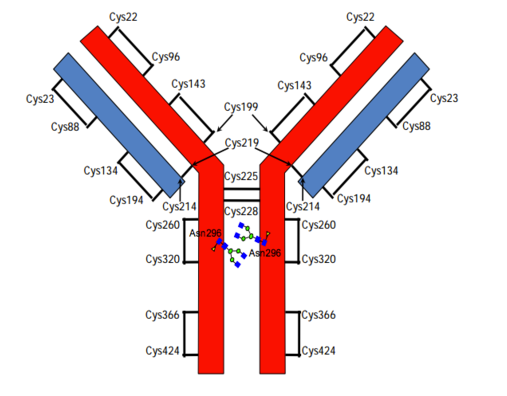Ramucirumab
Other name
-
International/Other brands
Cyramza
Groups
Approved
Structure

Prescription products
| Name | Dosage | Strength | Route | Labeller |
|---|---|---|---|---|
| Cyramza | Solution | 10 mg | Intravenous | Eli Lilly & Co. Ltd. |
| Cyramza | Solution | 10 mg/mL | Intravenous | Eli Lilly & Co. Ltd. |
Target
-
Description
Ramucirumab is a human monoclonal antibody (IgG1) against vascular endothelial growth factor receptor 2 (VEGFR2), a type II trans-membrane tyrosine kinase receptor expressed on endothelial cells. By binding to VEGFR2, ramucirumab prevents binding of its ligands (VEGF-A, VEGF-C, and VEGF-D), thereby preventing VEGF-stimulated receptor phosphorylation and downstream ligand-induced proliferation, permeability, and migration of human endothelial cells. VEGFR stimulation also mediates downstream signalling required for angiogenesis and is postulated to be heavily involved in cancer progression, making it a highly likely drug target. In contrast to other agents directed against VEGFR-2, ramucirumab binds a specific epitope on the extracellular domain of VEGFR-2, thereby blocking all VEGF ligands from binding to it. Ramucirumab is indicated for us in advanced gastric or gastro-esophageal junction adenocarcinoma as a single agent or in combination with paclitaxel after prior fluoropyrimidine- or platinum-containing chemotherapy.
Indications
Advanced Gastric Cancer; Advanced gastro-esophageal junction adenocarcinoma; Refractory, metastatic Colorectal cancer; Refractory, metastatic non small-cell lung cancer
Other indications
-
Mechaism of action
-
Absorption
-
Metabolism
-
Toxicity
Ramucirumab packaging includes warnings for arterial thromboembolic events, hypertension, infusion-related reactions, gastrointestinal perforation, clinical deterioration in patients with cirrhosis, and reversible posterior leukoencephalopathy syndrome. The most common reactions observed in single-agent-treated patients at a rate of >10% and >2% higher than placebo were hypertension and diarrhea. The most common adverse reactions observed in patients treated with ramucirumab plus paclitaxel at a rate of of >30% and >2% higher than placebo plus paclitaxel were fatigue, neutropenia, diarrhea, and epistaxis.